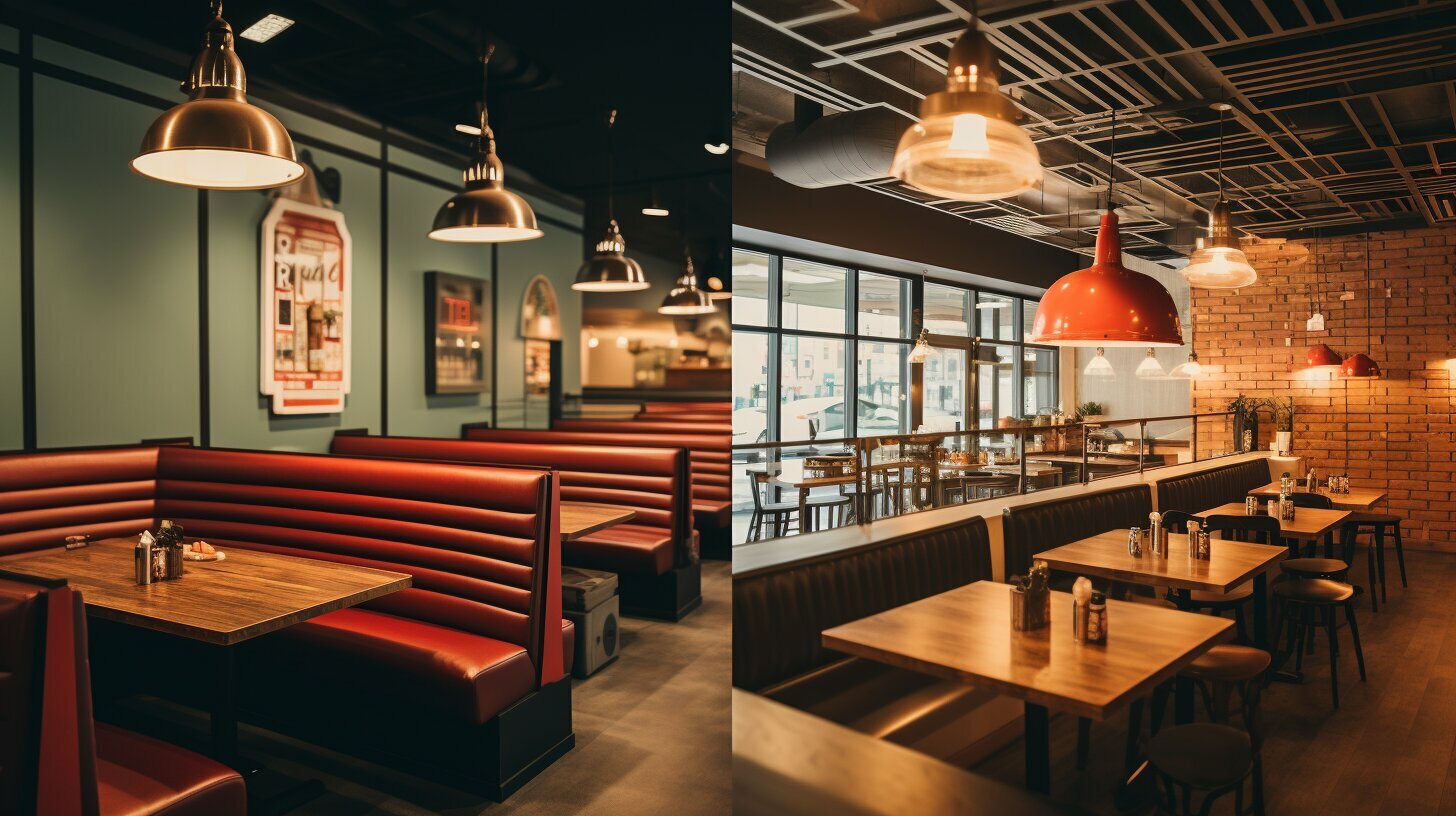When it comes to dining out, there are many types of establishments to choose from, including eateries and restaurants. While these terms are often used interchangeably, there are some key differences between the two. In this section, we will explore the definitions and meanings of “eatery” and “restaurant,” as well as how they differ from each other.
Key Takeaways:
- Eateries and restaurants are both types of establishments where customers can dine out.
- There are some key differences between the two, including their ambiance, service, food choices, and price range.
- Understanding these differences can help individuals choose the dining experience that best fits their preferences and needs.
Ambiance and Atmosphere
Restaurants come in a variety of types, such as diners, cafes, bistros, brasseries, and trattorias. Each has its own unique ambiance and atmosphere that sets it apart from eateries.
Diners are known for their cozy, casual atmosphere and often have a retro vibe. These establishments typically serve classic American breakfast and comfort food dishes. On the other hand, cafes have a more sophisticated atmosphere, with a focus on artisanal coffee and baked goods. They may also offer light meals and sandwiches.
Bistros are quaint, cozy establishments that serve simple, rustic meals. They often have a French influence and feature fresh, locally sourced ingredients. Brasseries, on the other hand, are typically larger and more formal than bistros. They are known for their refined atmosphere and serve a wide range of classic French dishes.
Trattorias are Italian-style eateries that offer a cozy, family-friendly atmosphere. They typically serve classic Italian dishes like pizza and pasta, as well as a variety of antipasti and salads.
Service and Experience
When it comes to dining out, the service and experience offered by an establishment can be just as important as the food itself. Two factors that can greatly influence the service and experience are the type of restaurant and the dining style.
Casual dining vs fine dining: One of the biggest differences in service and experience can be found between casual dining and fine dining establishments. Casual dining restaurants typically offer a more relaxed atmosphere with a focus on comfort and convenience. In contrast, fine dining restaurants tend to offer a more formal experience, with a higher level of service and attention to detail.
Fast food vs sit-down restaurants: Another key factor in the service and experience is the dining style. Fast food restaurants typically offer quick and efficient service with self-service options. Sit-down restaurants offer a more traditional dining experience, with table service and a dedicated wait staff.
Casual restaurant definition: A casual restaurant is typically a type of eatery that offers a relaxed atmosphere and affordable dining options. These establishments may offer counter service or table service and serve a wide range of cuisine, from burgers and fries to ethnic foods and gourmet fare.
Overall, the type of restaurant and dining style can greatly impact the service and experience offered by an establishment. It’s important to consider these factors when choosing a restaurant to ensure you have the dining experience you desire.
Food Choices and Menu
One of the most significant differences between an eatery and a restaurant is the type of food they serve. Eateries often offer a more casual and straightforward menu with limited options. In contrast, restaurants typically have a broader range of dishes and cuisines on their menu.
Restaurants can be further divided into various categories based on the type of food they serve, such as Italian, Chinese, Mexican, and Indian. Each type of restaurant has its own specialty dishes, which are typically not available at an eatery.
Eateries, on the other hand, may specialize in a specific type of cuisine or offer a limited menu that includes popular items such as sandwiches, burgers, and fries. These types of establishments are often more casual and cater to customers who are looking for a quick and convenient meal.
Examples of Different Types of Restaurants
Some of the different types of restaurants include fine dining establishments, cafes, bistros, and fast food chains. These restaurants vary in terms of menu, price range, and target customer base.
| Restaurant Type | Menu | Price Range | Target Customer Base |
|---|---|---|---|
| Fine Dining | Top-quality ingredients, specialty dishes, extensive wine list | Expensive | High-income customers, special occasions |
| Cafe | Coffee, light meals, pastries, sandwiches | Mid-range | Students, professionals, casual diners |
| Bistro | French cuisine, rustic dishes, wine selection | Mid-range to expensive | Foodies, romantic couples, casual diners |
| Fast Food Chain | Burgers, fries, chicken sandwiches, soft drinks | Inexpensive | People on the go, budget-conscious consumers |
Ultimately, the type of restaurant or eatery that you choose will depend on your preferences, budget, and the occasion. Whether you’re looking for a cheap and quick meal or a fine dining experience, there are many different options available to suit your needs.
Price Range and Customer Base
One of the most significant differences between eateries and restaurants is the price range and customer base. Eateries generally have more affordable prices, making them more accessible to a broader range of customers. They are often frequented by families, college students, and individuals on a budget.
On the other hand, restaurants tend to be more expensive, catering to a more upscale clientele. Fine dining establishments, in particular, have higher prices due to the high-quality ingredients and level of service provided. These types of restaurants are typically frequented by business professionals, couples, and individuals celebrating special occasions.
The customer base for different types of restaurants can also vary. Fast food restaurants, for example, attract customers looking for a quick and convenient meal, while sit-down restaurants may cater to individuals looking for a more relaxed dining experience. Additionally, themed restaurants, such as those offering a specific cuisine or atmosphere, may attract customers with a particular interest or taste.
Conclusion
In summary, understanding the difference between an eatery and a restaurant is crucial when deciding where to dine out. Both establishments offer unique experiences in terms of their ambiance, service, food choices, price range, and customer base.
Whether you prefer a casual meal at a diner or a fine dining experience at a restaurant, knowing the distinctions between these types of establishments can help you make an informed decision.
So, the next time you’re planning a night out, take a moment to consider what type of dining experience you’re in the mood for. Are you looking for a laid-back atmosphere or a sophisticated ambiance? Do you want a quick bite or a leisurely meal? By answering these questions, you’ll be better equipped to choose between an eatery and a restaurant.
We hope this article has been informative and helpful. Happy dining!
 Skip to main content
Skip to main content



